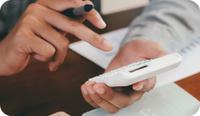Sensory Processing Measures

Many of the clients we work with have sensory needs, which is why sensory processing measures are useful tools. In this article, we will go over the Sensory Processing Measure-2, a popular sensory processing assessment used by occupational therapists (OTs).
There are many caveats to sensory processing—from tactile to auditory sensitivity. Sensory processing measure forms can be excellent ways to better understand the sensory needs of your clients.
The Sensory Processing Measure-2 is meant to look at clients across environments by giving questionnaires to caregivers, teachers, or the clients themselves. It can give a therapist a much better understanding of a client’s sensory processing without the need for lengthy observations of the client.
This article will focus on sensory processing measure scoring, including the Sensory Processing Measure- 2 and the difference between this Sensory Processing Measure and the Sensory Profile.
What is the Sensory Processing Measure?
The Sensory Processing Measure-2 (SPM-2), developed by occupational therapists L. Diane Parham, Cheryl L. Ecker, Heather Kuhaneck, Diana A. Henry, and Tara J. Glennon, is a set of norm-referenced rating scales.
The second edition of the Sensory Processing Measure aims to identify difficulties a person may have that impact their ability to engage in daily activities, learn, or interact in various environments.
Once the difficulties have been identified, the clinician can develop strategies and interventions that will support the individual’s needs. The SPM-2 assesses social participation, motor planning, and sensory processing across multiple environments, including home, school, and the larger community. It also covers five different age groups: infant/toddler, preschool, child, adolescent, and adult, with an age range of 4 months to 87 years.
Using a 4-point rating scale, the SPM-2 assesses clients in eight categories:
- Olfactory
- Vestibular
- Tactile
- Auditory
- Visual
- Proprioceptive
- Praxis
- Environmental
The SPM-2 was released in 2021, updated from the Sensory Processing Measure that was published in 2002.
While much of the measure remains the same, there were some changes based on age ranges that were broken up into five categories: infant/toddler, preschool, child, adolescent, and adult.
The SPM-2 continues to use Ayres Sensory Integration Theory as its foundation. The updated measure was expanded and standardized on 3,850 typically developing subjects ranging from four months to 87 years from the United States.
Each of the five age range forms gathers sensory ratings captured by specific people in specific settings:
- Infant/toddler (4-30 months): includes a caregiver form and a form for the caregiver to rate their own sensory integration.
- Preschool (2-5 years): home and school forms are rated by the caregiver and school staff.
- School age (5-12 years): home and school caregiver/teacher forms, including school environment forms (cafeteria, music, art, bus, playground, and physical education).
- Adolescent (12-21 years): school teacher form, home caregiver form, self-report, and adolescent driving environment forms.
- Adult (21-87 years): rater, self-report, and adult driving environment forms.
All forms can be used separately or together. Scores can be compared between respondents (for example, the self-report measure compared to the caregiver’s report). Each form has 80 items.
The updated Sensory Processing Measure also contains a quick tips guide (for children only). The guide offers intervention strategies specific to each item.
If you are using the online evaluation system, you can create individualized quick tip reports with activities for your client. The addition of quick tips can make it easier for therapists to prioritize areas of need and create a plan of care.
How to score the Sensory Processing Measure
Scoring for the SPM-2 is straightforward. Scores in each section are tallied, and raw scores are converted into T-scores.
The T-scores fall into three ranges: typical, moderate difficulties, or severe difficulties. Percentile and difference (DIF) scores are also given.
With the paper form, the evaluator will have to tally scores by hand. If using the online evaluation system, WPS scores the SPM-2 and generates a report.
Each form takes an estimated 20 to 30 minutes to fill out, and the environmental forms take about 10 minutes.
A client will receive scores in eight areas:
- Vision
- Hearing
- Touch
- Taste and smell
- Body awareness
- Balance and motion
- Total sensory (a composite score of the above six areas)
- Praxis (planning)
- Social participation
The latter two scales are considered outcomes affected by sensory processing.
If a client’s scores fall in the moderate or severe range, the testing authors recommend item-level interpretation of the scores.
Where can the SPM-2 be purchased?
You can purchase the SPM-2 from WPS, an American Occupational Therapy Association (AOTA) approved provider of assessments and continuing education.
You have the ability to purchase hard copy forms (25 forms in a pack), the SPM-2 manual, the SPM-2 quick tips, or the online version of the measure through the WPS online evaluation system.
The online system allows 5 to 25 uses depending on the forms you need. You can also purchase the entire kit or forms for a specific age group. The SPM-2 also comes in Spanish.
Note: The SPM-2 was updated in 2021. When an assessment gets updated, practitioners frequently have leftover forms of the older version of an assessment. While it can be tempting to try to use up the old assessment forms, it is best practice to use the most current version of any assessment.
Sensory Processing Measure vs. Sensory Profile
There are often questions about the difference between the Sensory Processing Measure-2 (SPM-2) and the Sensory Profile 2 (SP2).
While there are many similarities between the two assessments, there are also many differences.
Both assess sensory processing function at home and school. The SPM-2 also looks at social participation and praxis.
The SP2 looks at sensory processing patterns and their impact on functional performance. It analyzes neurological thresholds and responses connected with behavioral and emotional self-regulation in everyday life.
Each test addresses sensory processing in different ways, so clinicians will need to use their professional judgment to determine which test will be best for their individual clients.
Key takeaways about the SPM-2
The SPM-2 is a comprehensive measure that can be used across a lifespan. With its educational insights and tailored interventions, the SPM-2 can help clinicians, families, and schools make informed decisions about a person’s sensory processing.
The second edition of the Sensory Processing Measure can guide those who see clients with sensory processing difficulties in providing a more supportive environment to help them successfully go about their daily activities.
Some features to highlight about the SPM-2:
- It is a comprehensive measure that looks at sensory processing from multiple perspectives, including caregivers, teachers, and one’s self.
- It is easy to administer, and each form only takes between 10 to 20 minutes to complete.
- The online evaluation tool saves time by scoring the measure and generating a report.
- It can help recognize patterns in sensory processing difficulties and can highlight correlations between sensory processing difficulties and behavior.
Practice management software for occupational therapists
Start and grow your occupational therapy practice with SimplePractice—an easy-to-use, fully integrated EHR solution trusted by more than 185,000 practitioners nationwide.
- Effectively manage scheduling, billing, documentation, and more.
- Stay secure with a HIPAA-compliant solution you can trust.
- Take your practice on-the-go with a convenient mobile app that lets you effectively treat clients during home visits, community visits, or virtually.
Try SimplePractice free for 30 days. No credit card needed.
Discover the all-in-one
EHR used by OTs
everywhere
Start for free
More Stories
Stay inspired
Get the latest stories from your peers right to your inbox.









